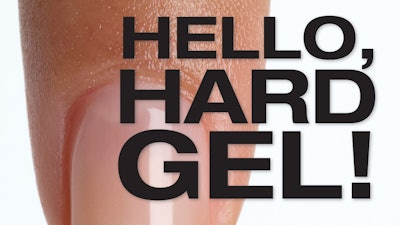
As longer nails continue to trend, even the most conservative clients can’t help but be curious about enhancements. Unfortunately, many newbie nail customers tend to lump them all into one daunting category, which may be accompanied by a fear of fumes, nail damage and other potentially misplaced apprehensions. However, like other professional products, when used properly, hard gel boasts plenty of compelling qualities that clients (and techs!) should be talking about. Here, experts reacquaint you with the basics and benefits of hard gel, and share important tips for application and removal. After a proper introduction, your clients will be saying “hello” to hard gel as well!
Meet Hard Gel
Technically speaking, hard gel (also called traditional or standard gel) is similar to acrylic in its chemical makeup. It’s made of monomers and/or oligomers (chains of monomers) plus other ingredients that help the gel remain workable, adhere to the nail, harden properly and resist yellowing. Hard gel is applied to the nail straight from the pot (no mix ratio required) and each layer is cured under a UV or LED light. The curing process, called polymerization, creates a strong, compact polymer that solvents can’t penetrate—which means hard gel can only be removed by filing. After curing, a tacky film of uncured gel, called the inhibition layer, is left and must be removed with nail cleanser.
Acrylic, on the other hand, is composed of a liquid monomer and powder polymer. When combined, a catalyst in the monomer reacts with an initiator in the polymer causing the mixture to harden. An acrylic nail is more porous (less compact) than hard gel, allowing solvents to penetrate the surface and break down the product for removal. These are important differences for you to know so you can properly educate your clients.
Create a Connection
How do hard gel’s distinct attributes translate into real benefits for clients and techs? First, no monomer means hard gel is essentially odorless, making the appointment more pleasant for those sensitive to smells, says Somer Adams, owner of Labella Salon in Glastonbary, Connecticut. “Clients who are sensitive to acrylic may be able to wear hard gel with no issues,” notes Allie Baker, EzFlow global brand ambassador, based in Medford, Oregon.
The pre-mixed formula ups the ante further on hard gel’s many advantages. “It’s always the perfect consistency right out of the jar,” says Adams. The one-step application is not only easy, but also a great option for clients who may have lifting problems with acrylic—which can often be the result of the wrong liquid/powder ratio. Because the chemical reaction has already occurred with hard gel, it takes the mixing ratio out of the equation, explains Allison Ross, a SuperNail educator based in South Jordan, Utah, who reaches for hard gel when other products aren’t working. “When in doubt,” she says, “gel will get the job done!”
Novice techs appreciate the self-leveling and easy to manipulate qualities of gel, and those who work in warmer climates (where acrylics cure quickly) find the unlimited timeframe for application appealing “You can work with gel until you’re satisfied with the application, then cure,” says Ross.
Finally, hard gel’s tough, non-porous surface is unfazed by acetone, dyes and other chemicals—one reason that Orange County, California-based Vicki Ornellas, ibd global educator, uses hard gel on hair stylists, who would otherwise have color stains on their nails. “Just seal any product with clear hard gel, and hair color can’t penetrate and change the color,” she says. Bottom line? Hard gel is durable but flexible, and great for clients looking for a lightweight, natural-looking enhancement, says Baker.
Hit It Off
Ready for a hard gel hookup? The key is good products and tools, quality education, flawless application and careful removal. When selecting products, keep in mind that individual brand gel systems are designed to work perfectly together, so for best results, avoid mixing products from multiple manufacturers. Most experts also prefer to apply hard gel with a high-quality synthetic or natural-hair brush with a smaller, firmer brush head for maximum gel control. Lamps are important, too. Follow the manufacturer’s guidelines for curing times, and change bulbs regularly.
When it comes to applying product, don’t make the mistake of overworking the gel and pressing too hard, says Ornellas. This introduces air into the product and can lead to cracking. “You really just need a feather-soft touch. Let the product level on its own,” she adds. Baker cautions that overworking the product can also make the nail lumpier, creating more filing for the tech once cured. Additional application insights: For clients with longer nails, reinforce the stress area to reduce the chances of a break, advises Adams. Also, avoid too much product at the cuticle area, because any gel touching the skin will cause lifting. For runnier formulas, you may need to flash cure as you work to keep it from flooding the cuticle.
Finally, remember that natural nail damage from the use of hard gels is really the result of one thing: improper removal. Over-filing or prying off gels can cause severe damage to the nail plate and is a surefire way to lose a client forever. Begin with a coarse file and reduce the grit as you approach the natural nail. If using an e-file, switch to a hand file as you get closer to the nail plate. Pros recommend leaving a very thin layer of product behind on the nail, as it offers the nail a little extra protection (which is great if the client is transitioning from enhancements) and helps prevent over-filing. Plus, the remaining gel will grow out undetected with the natural nail.
Want to see hard gel in action? Watch the video below featuring Los Angeles-based nail tech Sabella Snyder create a pink-and-while with hard gel.
-Leslie Henry is a business development executive, licensed nail technician and the blogger behind workplaypolish.com.
This article was originally published in the January 2018 issue of NAILPRO.











